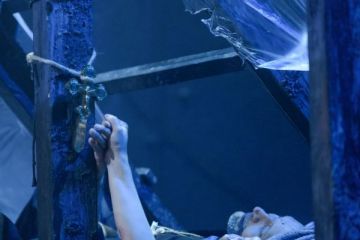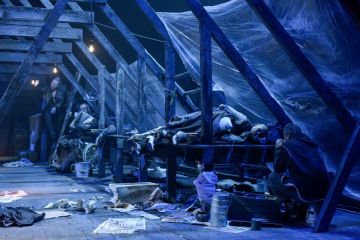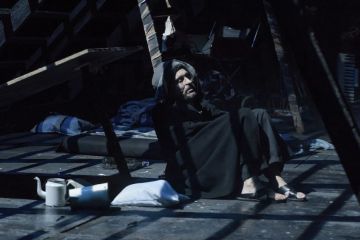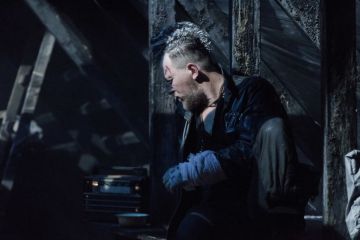(...) the image of all these thwarted fates is quite burdensome. Emotionally. Spiritually. Although each character has his or her own story, not all of them recount it. Beyond the monologues and the lines, beyond the words themselves, every single movement, every look, every physical approach or turning away - and everything else that the actor adds to the performance in somewhat unexplainable ways - unravels the story itself. And all the elements used by the director, the costume designer, the make-up artist, the entire staff come to support that common goal, so as we, the audience, can discover the character’s fate. Its truth, and pain, its secrets and desires. And also, its failures and fall. It becomes unbearable to see so many stateless, lonely people, who are hungry for love and understanding, who have nothing, who are addicted to alcohol and other substances, but who still believe, and want to keep on hoping, waiting for redemption, for a miracle, it is unbearable to see so many fallen angels in one place.
According to set and costume designer Dragoș Buhagiar the space where the play takes place is a burnt down attic space, with the naked skeleton of the wooden structure - the beams and the joist, covered in a thin nylon sheet to protect against the wind (one of the background noises of the performance is the cracking noise made by the sheet), open on the other end, but always dark, gloomy and desolate, both realistic (since the space is heated by a furnace) and abstract (the space can be exited by climbing three separate ladders - for only the owners use the entrance in the back of the stage).
Nobody arrives from the outside into this world. Nobody except Luka (Zsolt Bogdán), that is, but he has a different function in this context: he is a phenomenon, a legend, a messenger, or perhaps even the hero in a western in whom we want to believe - because we always need to believe in something, if nothing else, then in the fact that people are fundamentally good.
Réka Hegyi:
Ecce homo, Játéktér, November 21, 2016
The choice of title undoubtedly has its own significance. And it's not just about its immediate significance, a telling one that relates to the social status of those who reside in Michael Kostilov’s small hotel business, but about securing the very essence of the staging beginning from the title itself. Fundamentally, it is based on the amalgam of contradictions that were very carefully thought-out, designed to reveal the bizarre way of being of the people who inhabit the asylum. The people of the lower depths, who are devoid of spiritual depths.
On the bottom time passes differently than it does on the surface, it passes slowly at times, lazily at other times, or even sluggishly, then, suddenly, it becomes hyper-focused, rebellious, and uncontrollable by anyone, its rhythm becoming downright devastating. At the bottom is a defining element of what the cult of details means and the level of attention required from the part of the audience member, who, for instance, has to pay attention to the manner in which the last hours of Anna’s life are spent or the way The Actor prepares for his own death. Finally, At the bottom is a performance where we witness individual and ensemble victories concerning acting. In which the wonderful ensemble of the Hungarian Theater of Cluj shines in its full glory. I think it would be unjust and critically unwise of me now to start to qualify or use adjectives to evaluate each person’s performance. For every single role played would deserve a thorough, detailed character analysis. The merit of Yuri Kordonsky and the entire ensemble lies in the fact that they managed to erase the distinctions between the leading and the supporting roles. For there is something absolutely surprising in each and every one of them.
A thrilling, impressive performance, that shakes you to your core. (…) Gorky’s classic play The Lower Depths is approached by the Russian director from the standpoint of humanism - of the human, I would be rather tempted to say - fully stripped of ideological inflections referenced by some lines, scenically portrayed with its full scale of passion and excess - be it in the way one lives, or in its austerity -, which characterizes the Slavic soul (which in our cultural space has become rather a cliché). However, it is not necessarily a Russian story, but an exemplary one, I would say, in which the sublime coexists with promiscuity, as does the most cruel death with the most heated love; hardened and cynical disbelief with the calmest and firmest faith; as well as vice with the hope of deliverance. A Hell places in the surroundings of the gate to Heaven appears in front of us in all its cruel details, a Hell perhaps purified that is perhaps clarified a bit by a celestial breeze, who knows. All this even if it seems that Heaven is empty, as if God would have taken His angels and would have gone elsewhere...
A carefully calibrated mix of textures (like that of wood, for instance), smells, volumes and perspectives, objects and structures that contain and express even by themselves a rich semantic horizon, make the set and costume design into a visual spectacle. It's one of the most striking and relevant approaches to costume and set design that we have seen in recent years.
A hermeneutical-literary study deserves to be written regarding the flawless directorial approach of the play, for it raises to a different level the "interpretation" of Gorky's play, which has been much too burdened, in the last few decades, by ideological abuse. Kordonsky returns it to its rightful place among other great dramas, which possess a permanent potential towards a spectacle. However, neither Yuri Kordonsky’s directorial concept, nor the art of Dragoș Buhagiar’s scenography would have been enough without the exceptional, thrilling, bewildering, energetic, incandescent performance from the part of the actors of the Hungarian Theatre of Cluj, who have once again demonstrated their impressive strength. Each one was equal to him/herself along the extensive and difficult performance, without losing their energy or rhythm, each person was seen, each had his/her moment of grace - moments of force or despair for the character, of passion or retractability, of finesse or of great outbursts. A memorable, breathtaking interpretation.
The Hungarian Theatre of Cluj-Napoca has managed once again to provide to the excellent actors it now has a text upon which to express their immense acting potential with The Lower Depths, directed by Yuri Kordonsky, scenography by Dragoș Buhagiar. (…) The director has succeeded in providing strong formulas for approaching a theatrical play, therefore, the combination of the scenographic version proposed by Dragoș Buhagiar, the selected text and the versatility of the actors have all generated a ravishing performance. The subject has the ability to be very timely, although the marginal world had not been exploited on stage at the beginning of the 20th century in this manner. A night asylum, a place of failed destinies, of transformed stories and personalities, humiliated and kept at the surface, on the edge of existence by just pure survival instinct. Their lives there is disturbed by the arrival of a new tenant, Luke. He senses the path of salvation from that inferno of misery and failure, a dream-like one, thanks to the ideals and dreams of those who live in it. Satine, who argues that lucidity is the only possible way out is the one upon which the realistic line is constructed. The shattered shred of life in that asylum takes places between these two tendencies, a mixture of violence and tenderness, kindness and selfishness, indifference and subtlety.
At one point, I gave up on following the transposition of the text, since the magic of the universal language of compassion, the strong emotion from and to the stage made words become almost useless in meaning, while the sonority, the timbre of the actors’ voices, all the energy woven into the ebb and flow between the actors and the audience to combine perfectly.
For us, the audience, nothing else remains but to find courage within ourselves to return to “The Lower Depths” in order to perceive the richness of troubling scenes, symbols, the kaleidoscopic multitude of the details that were revealed simultaneously in several corners of the stage. How to choose between scenes? Which fragment should I bring to your attention? I will not do that, but rather leave you the satisfaction to discover a performance that stays with you for a while, long after you leave that magical space.
The co-ordination and choreography of actors in the space of the asylum is meticulously calculated and stretches from the one edge of the stage to the other. Kordonsky adds layers of small and detailed actions that create the agitated atmosphere of a space inhabited by 11 people burdened by their own dramas. Gorki's text is brought to the forefront by the actors, Kordonsky being merely the hand that guides from the background, treating the material with the utmost respect. Not a hint of megalomania. Not a trace of didacticism.
UNITER award for the Best Director for Yuri Kordonsky (2016).
Best light design - Yuri Kordonsky and Dragoș Buhagiar, National Theatre Festival, Pécs, Hungary, 2017.




































